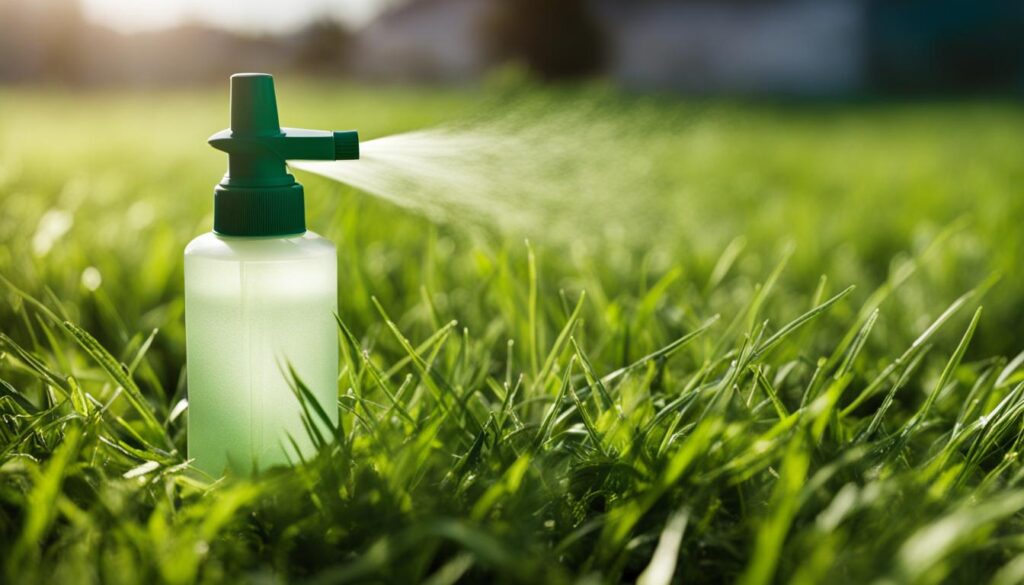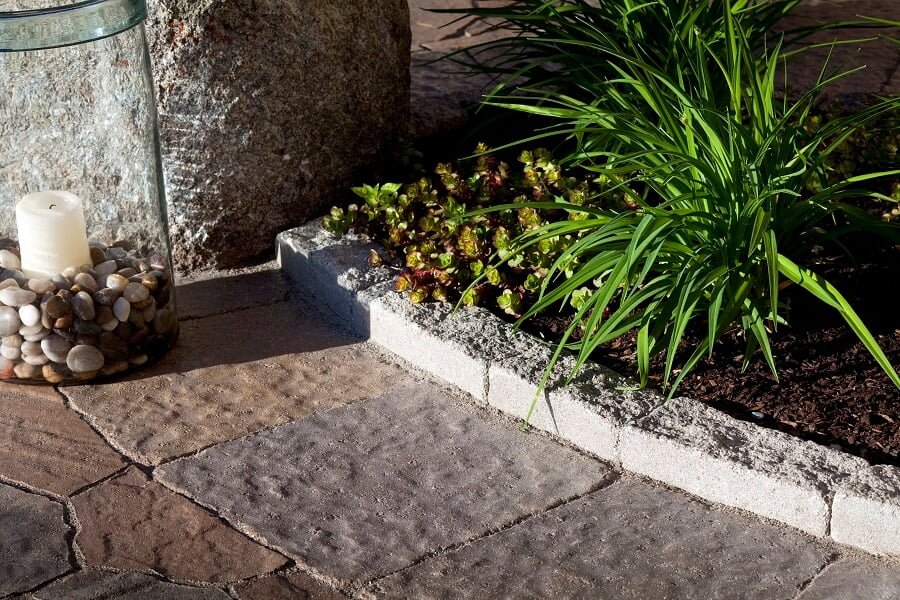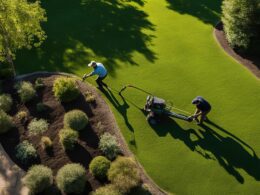To effectively get rid of fleas in your yard and prevent future infestations, it is important to understand where fleas hide and how to target their habitats. Treating the yard is crucial, especially if your pets spend a lot of time outside. This section will provide you with the necessary information to eliminate fleas from your yard and maintain a pest-free outdoor space.
Key Takeaways:
- Understanding where fleas hide in the yard is essential for effective treatment.
- Regularly check areas near trees, fences, and the perimeter of your yard for flea infestations.
- Preparing your yard by removing debris and mowing the lawn is crucial before flea treatment.
- Flooding the yard with water can eliminate fleas at all life stages.
- Using insecticides, nematodes, and cedar chips are additional methods for flea control in the yard.
Finding Fleas in Your Yard
To begin the flea treatment in your yard, you need to locate the flea infestations. Fleas are often found in warm, shady, and moist areas, so it’s important to check the spots where they may be hiding. Start by inspecting places where your pets usually hang out, such as the doghouse or garden furniture. Pay close attention to areas near trees, fences, and the perimeter of your yard, as fleas tend to accumulate in these areas.
One useful trick to help you spot fleas is to wear white socks while walking around the yard. The contrast between the black fleas and the white socks makes them easier to identify. Remember to thoroughly check multiple areas in the yard to ensure that all flea infestations are found and treated.
Expert Tip: Fleas can be sneaky and hard to find, so be patient and thorough in your search. Don’t forget to check hidden corners and crevices where fleas may be lurking.
Once you have located the flea hiding spots in your yard, it’s time to proceed with the flea treatment. By effectively eliminating fleas, you can create a flea-free outdoor environment for you and your pets to enjoy.
Coming up in the next section: Preparing Your Yard for Flea Treatment.
Preparing Your Yard for Flea Treatment
Before you begin the flea treatment in your yard, it’s crucial to prepare the area properly. Taking these necessary steps will help ensure the effectiveness of your efforts and maximize the chances of eliminating fleas from your outdoor space.
First and foremost, remove any clutter or debris that may provide hiding spots for fleas. This includes old pet toys, piles of grass cuttings, and any other objects that may serve as flea habitats. Clearing these areas will create a less appealing environment for fleas and make the treatment more targeted and effective.
Next, consider mowing the lawn and trimming it to a shorter height. This will not only make it easier to treat the yard but also disrupt the flea habitat. Fleas thrive in tall grass, so by keeping the lawn well-maintained, you reduce their hiding places and expose them to the treatment.
Tip: After mowing, remember to dispose of the grass clippings properly. Leaving them in the yard may provide additional shelter for fleas.
During the yard treatment, it’s important to keep your pets indoors. This prevents them from potentially coming into contact with the flea treatment and bringing it back inside. By keeping your pets away from the treated area, you minimize the chances of re-infestation and ensure their safety.
By following these steps and preparing your yard for flea treatment, you set the stage for a successful elimination of fleas in your outdoor space. Removing debris, mowing the lawn, and keeping your pets indoors create an environment that is less conducive to flea habitation, making it easier to get rid of these pests once and for all.
Flooding the Yard with Water
One effective way to eliminate fleas in the yard is by flooding the entire area with water. Flea larvae and eggs cannot survive in flooded conditions, so this method targets all stages of the flea life cycle. By flooding the yard, you can eliminate the existing fleas and prevent new infestations from occurring.
To flood the yard, start by turning on your garden hose and setting it to a strong stream. Begin at one end of the yard and work your way across, ensuring that the water reaches all areas. Pay close attention to spots near trees, fences, garden furniture, and the doghouse, as these are common hiding places for fleas.
Continue flooding the yard for at least 15 minutes to thoroughly saturate the soil. This will drown any flea larvae and eggs present in the yard, ensuring their complete elimination. Repeat this process regularly to prevent fleas from breeding and keep your outdoor space flea-free.
Spraying the Yard with Insecticides
When it comes to flea control in your yard, spraying insecticides is a highly effective method. By choosing an environmentally friendly pesticide and following the instructions carefully, you can ensure safe application. Before you start spraying, remember to remove any toys or objects that come in contact with your pets or children.
Pay extra attention to areas where fleas are commonly found, such as near trees, fences, and the doghouse. These are the hotspots for flea infestations in the yard. Treat the entire yard or focus on specific areas where your pets spend time outdoors. It is important to repeat the treatment as required to achieve long-lasting flea control.
Using Nematodes for Fleas
When it comes to natural flea control in your yard, beneficial nematodes are a fantastic option. These microscopic worms are a safe and effective way to combat flea larvae and other insects without harming humans, pets, plants, or the environment.
To use nematodes for flea treatment, mix them with water and distribute the solution across your yard. Make sure to spray it on bushes, shrubs, and the lawn, focusing on areas where fleas are commonly found. Keeping the soil moist after application allows the nematodes to reproduce and continue hunting down fleas and other pests.
Beneficial nematodes serve as a natural solution to the challenge of flea control, providing an environmentally friendly alternative to chemical treatments. By incorporating nematodes into your flea treatment plan, you can effectively target and eliminate flea larvae and eggs, ensuring your yard remains flea-free.
For a visual representation of nematodes and their effectiveness in flea control, take a look at the image below:
Using Cedar Chips to Repel Fleas
If you’re looking for a natural and effective way to repel fleas from your yard, consider using cedar chips. Fleas have a strong dislike for the smell of cedar, making it an excellent deterrent. By spreading cedar chips generously around your yard, especially along the outer fences and under bushes and shrubs, you can create a barrier that keeps fleas away.
Cedar chips are easy to find at your local garden center or online, and they are a safe option for both pets and humans. The natural aroma of cedar will help prevent new fleas from entering your yard, ensuring a flea-free environment for your outdoor space.
To use cedar chips as a flea repellent, simply scatter them around the areas where fleas are likely to hide or enter your yard. The strong aroma will deter fleas from approaching, and the chips will gradually release oils that continue to repel the insects over time.
Tip: For maximum effectiveness, replenish the cedar chips every few months or as needed to maintain the fresh scent.
In addition to deterring fleas, cedar chips can also provide added benefits. They help control odor and absorb moisture, creating a pleasant environment for you and your pets. Cedar chips are a popular choice for pet bedding and can be added to dog houses or kennels to repel fleas and ticks.
When using cedar chips, remember to spread them evenly and generously to cover the desired areas. Focus on the perimeter of your yard, as well as shady spots where fleas are commonly found. By taking preventive measures like using cedar chips, you can create a flea-free yard and enjoy your outdoor space without the hassle of flea infestations.
Now that you know how cedar chips can be used as a flea repellent, let’s move on to the next section, where we’ll explore other preventive measures to keep your yard flea-free.
Conclusion
Eliminating fleas from your yard is crucial for maintaining a pest-free outdoor space and preventing flea infestations in your home. By implementing a comprehensive flea treatment plan, you can effectively control fleas and enjoy a flea-free yard.
There are several methods and treatments available for flea control in yards. Flooding the yard with water is an effective way to eliminate flea larvae and eggs, targeting all stages of the flea life cycle. Additionally, spraying the yard with insecticides can provide long-lasting flea control, especially when combined with environmentally friendly pesticides.
To take a natural approach, you can use beneficial nematodes, which are microscopic worms that feed on flea larvae. By applying nematodes to your yard, you can significantly reduce flea populations without harming your pets or the environment. Another natural option is cedar chips, which act as a flea repellent and can be spread around the yard to deter fleas from entering.
Remember to choose the flea treatment method that best suits your needs and follow the instructions carefully. Taking necessary precautions, such as removing debris and maintaining a clean outdoor space, can also help prevent flea infestations. If you encounter severe flea problems or need further assistance, it’s advisable to consult professionals in flea control for yards.
Is Dawn Dish Soap Safe and Effective for Killing Fleas in the Yard?
Yes, Dawn dish soap is safe and effective for killing fleas in the yard. A diluted solution can be sprayed directly onto the grass to safely eliminate fleas without causing any dawn dish soap grass damage. It’s a natural and affordable solution for flea control in outdoor spaces.
FAQ
What are some effective methods to kill fleas in the yard instantly?
Some effective methods to kill fleas in the yard instantly include flooding the yard with water, using insecticides, using nematodes, and spreading cedar chips as a natural repellent.
How can I locate fleas in my yard?
To locate fleas in your yard, check areas where pets usually hang out, such as the doghouse or garden furniture. Pay attention to areas near trees, fences, and the perimeter of the yard. Wearing white socks can make it easier to spot fleas.
How should I prepare my yard for flea treatment?
Before starting flea treatment, remove clutter and debris from the yard, such as old toys or piles of grass cuttings. Mow the lawn and trim it to a shorter height. Keep your pets indoors during the treatment.
How does flooding the yard with water help eliminate fleas?
Flooding the yard with water is an effective method as fleas cannot survive in flooded conditions. It targets all stages of the flea life cycle, including larvae and eggs. Flood areas near trees, fences, garden furniture, and the doghouse.
How do I spray the yard with insecticides?
Choose an environmentally friendly pesticide and carefully follow the instructions for safe application. Remove toys or objects that come in contact with pets or children. Pay extra attention to areas where fleas are commonly found, such as near trees, fences, and the doghouse. Treat the entire yard or specific areas where pets spend time.
How can I use nematodes for flea control in my yard?
Nematodes are beneficial microscopic worms that feed on flea larvae. Mix nematodes with water and spray the solution on bushes, shrubs, and the lawn. Keep the soil moist to allow nematodes to reproduce and continue hunting for fleas and other pests.
How can cedar chips help repel fleas in my yard?
Cedar chips have a smell that repels fleas, making them an effective deterrent. Spread cedar chips generously around the yard, especially along outer fences and under bushes and shrubs. This will help prevent new fleas from entering the yard.
How can I maintain a pest-free yard and prevent flea infestations?
To maintain a pest-free yard and prevent flea infestations, follow the recommended methods and treatments mentioned earlier. Choose the method that suits your needs, whether it’s flooding the yard with water, using insecticides, nematodes, or cedar chips. Take necessary precautions and consult professionals if needed.











